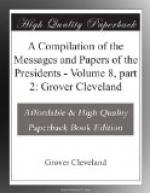Immediately after receiving his appointment he took the necessary steps for organizing his party, and in addition to two officers of the Corps of Topographical Engineers, assigned to him by the commandant of the Corps for this service, he called to his aid two civil engineers possessing the requisite qualifications for the duties to be performed. So soon as the requisite instruments could be procured and put in proper order he left New York for Portland, Me., where he arrived on the 5th of September, expecting there to join his colleagues of the commission. They had, however, proceeded to the points designated for the commencement of their respective duties, the season being too far advanced to justify their incurring any further delay.
At Portland a short conference was had with Mr. Stubbs, the agent of the State Department, who furnished the necessary means for procuring an outfit for the party in provisions, camp equipage, etc.
The party then proceeded to Bangor, where it was occupied until the 12th in procuring the necessary supplies of provisions, camp equipage, transportation, etc., to enable it to take the field; and a few astronomical observations were made here for the purpose of testing the rates of the chronometers which were to be used upon this service, as well as of obtaining additional data for computing the longitude of this place, which, together with the latitude, had been determined by the commissioner by a very near approximation in the summer of 1838, while occupied upon the military reconnoissances of the northeastern frontier.
On the 12th the party left Bangor for Houlton, where it arrived on the evening of the 13th. A depot of provisions was established here for supplying the line of their future operations, and the services of the requisite number of men as axmen, chain bearers, instrument carriers, etc., were engaged.
Pending these preparations and the time necessarily occupied in cutting a roadway through the forest from a convenient point on the Calais road to the monument at the source of the river St. Croix, a series of astronomical observations was made, both by day and by night, by which the latitude and longitude of Houlton were satisfactorily determined and the rates of the chronometers further tested.
By the 24th of September the roadway was sufficiently opened to permit a camp to be established upon the experimental line traced by the United States and British surveyors in the year 1817, when an attempt was made to mark this portion of the boundary between the two countries agreeably to the provisions of the treaty of Ghent of 1815.
The provisions and camp equipage were transported upon a strong but roughly constructed sled, drawn by horses, whilst the instruments were carried by hand, the surface of the country over which this roadway was opened being too rough for any wheeled vehicle to pass.
The point decided upon as the true source of the river St. Croix by the United States and British commissioners appointed for that purpose under the fifth article of the treaty of 1794 was found and identified, both by the inscriptions upon the monument erected there to mark the spot and also by the testimony of a living witness of high respectability, who has known the locality since it was first designated by the commissioners under the treaty of 1794.




